Analyzing Attachment Theory and its Effects on Migrant Children
VerifiedAdded on 2023/06/10
|6
|1517
|87
Essay
AI Summary
This essay delves into the concept of attachment, particularly focusing on its significance in the context of migrant children. It defines attachment as the emotional bond between a child and their caregiver, highlighting its importance for healthy development and emotional regulation. The essay discusses factors influencing attachment patterns, such as parenting styles, caregiver sensitivity, and the child's temperament. It further explores the detrimental effects of attachment deprivation, especially in institutionalized settings, leading to developmental delays, cognitive impairments, and emotional disturbances. The essay concludes by emphasizing the critical role of secure attachment in a child's well-being and the need for responsive caregiving to mitigate the adverse effects of migration and institutionalization. Desklib offers a range of resources, including past papers and solved assignments, to aid students in their studies.
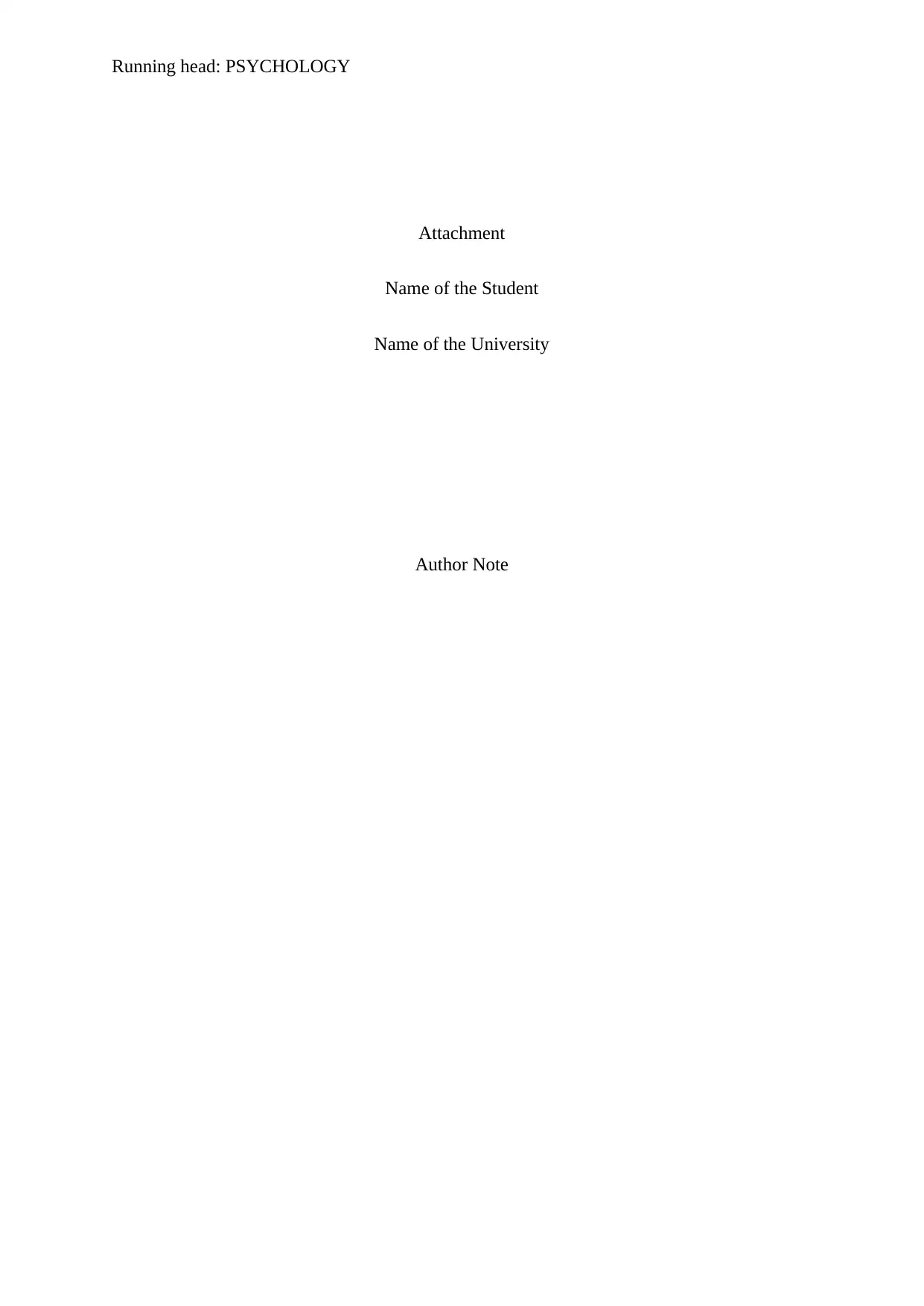
Running head: PSYCHOLOGY
Attachment
Name of the Student
Name of the University
Author Note
Attachment
Name of the Student
Name of the University
Author Note
Paraphrase This Document
Need a fresh take? Get an instant paraphrase of this document with our AI Paraphraser
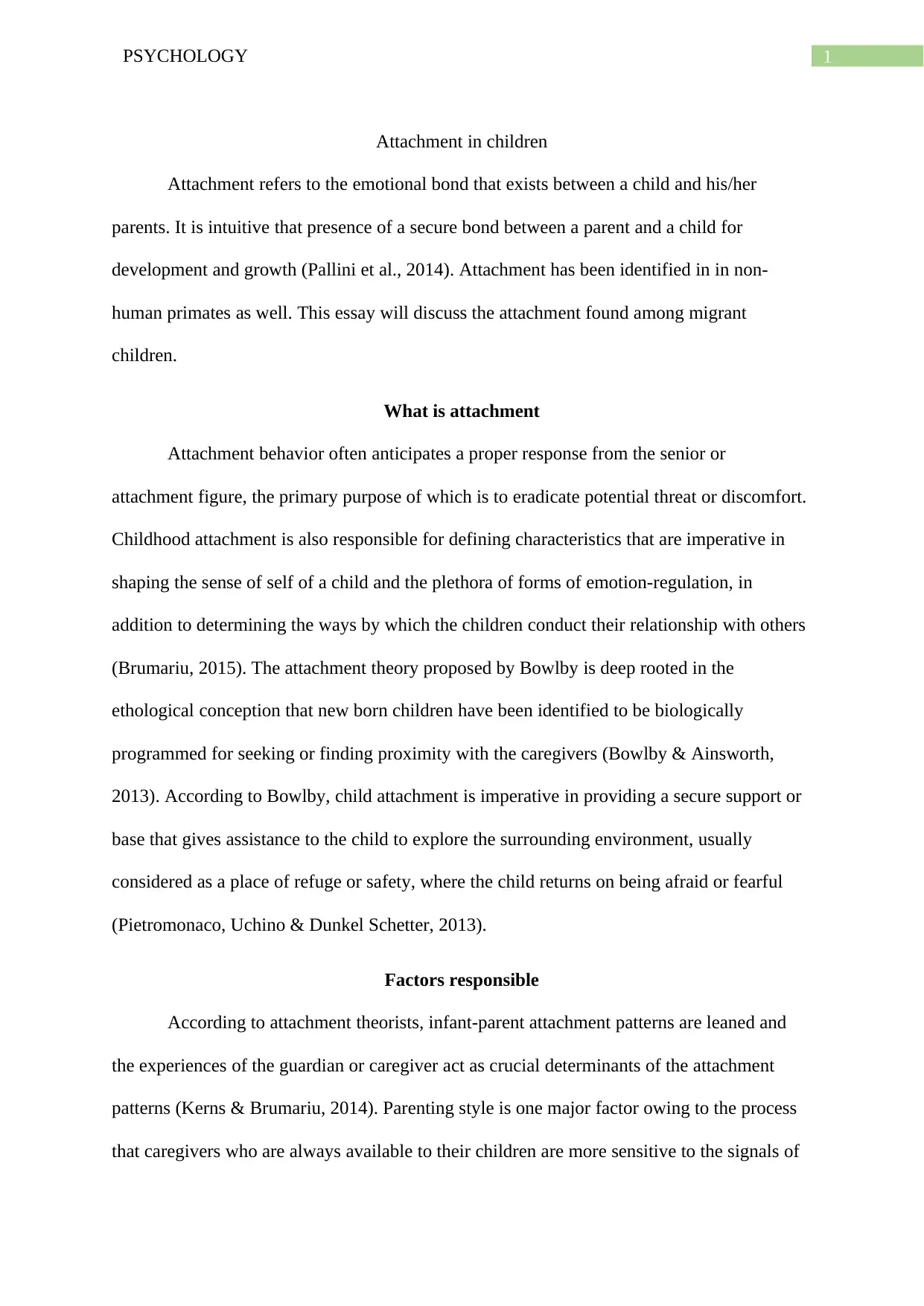
1PSYCHOLOGY
Attachment in children
Attachment refers to the emotional bond that exists between a child and his/her
parents. It is intuitive that presence of a secure bond between a parent and a child for
development and growth (Pallini et al., 2014). Attachment has been identified in in non-
human primates as well. This essay will discuss the attachment found among migrant
children.
What is attachment
Attachment behavior often anticipates a proper response from the senior or
attachment figure, the primary purpose of which is to eradicate potential threat or discomfort.
Childhood attachment is also responsible for defining characteristics that are imperative in
shaping the sense of self of a child and the plethora of forms of emotion-regulation, in
addition to determining the ways by which the children conduct their relationship with others
(Brumariu, 2015). The attachment theory proposed by Bowlby is deep rooted in the
ethological conception that new born children have been identified to be biologically
programmed for seeking or finding proximity with the caregivers (Bowlby & Ainsworth,
2013). According to Bowlby, child attachment is imperative in providing a secure support or
base that gives assistance to the child to explore the surrounding environment, usually
considered as a place of refuge or safety, where the child returns on being afraid or fearful
(Pietromonaco, Uchino & Dunkel Schetter, 2013).
Factors responsible
According to attachment theorists, infant-parent attachment patterns are leaned and
the experiences of the guardian or caregiver act as crucial determinants of the attachment
patterns (Kerns & Brumariu, 2014). Parenting style is one major factor owing to the process
that caregivers who are always available to their children are more sensitive to the signals of
Attachment in children
Attachment refers to the emotional bond that exists between a child and his/her
parents. It is intuitive that presence of a secure bond between a parent and a child for
development and growth (Pallini et al., 2014). Attachment has been identified in in non-
human primates as well. This essay will discuss the attachment found among migrant
children.
What is attachment
Attachment behavior often anticipates a proper response from the senior or
attachment figure, the primary purpose of which is to eradicate potential threat or discomfort.
Childhood attachment is also responsible for defining characteristics that are imperative in
shaping the sense of self of a child and the plethora of forms of emotion-regulation, in
addition to determining the ways by which the children conduct their relationship with others
(Brumariu, 2015). The attachment theory proposed by Bowlby is deep rooted in the
ethological conception that new born children have been identified to be biologically
programmed for seeking or finding proximity with the caregivers (Bowlby & Ainsworth,
2013). According to Bowlby, child attachment is imperative in providing a secure support or
base that gives assistance to the child to explore the surrounding environment, usually
considered as a place of refuge or safety, where the child returns on being afraid or fearful
(Pietromonaco, Uchino & Dunkel Schetter, 2013).
Factors responsible
According to attachment theorists, infant-parent attachment patterns are leaned and
the experiences of the guardian or caregiver act as crucial determinants of the attachment
patterns (Kerns & Brumariu, 2014). Parenting style is one major factor owing to the process
that caregivers who are always available to their children are more sensitive to the signals of
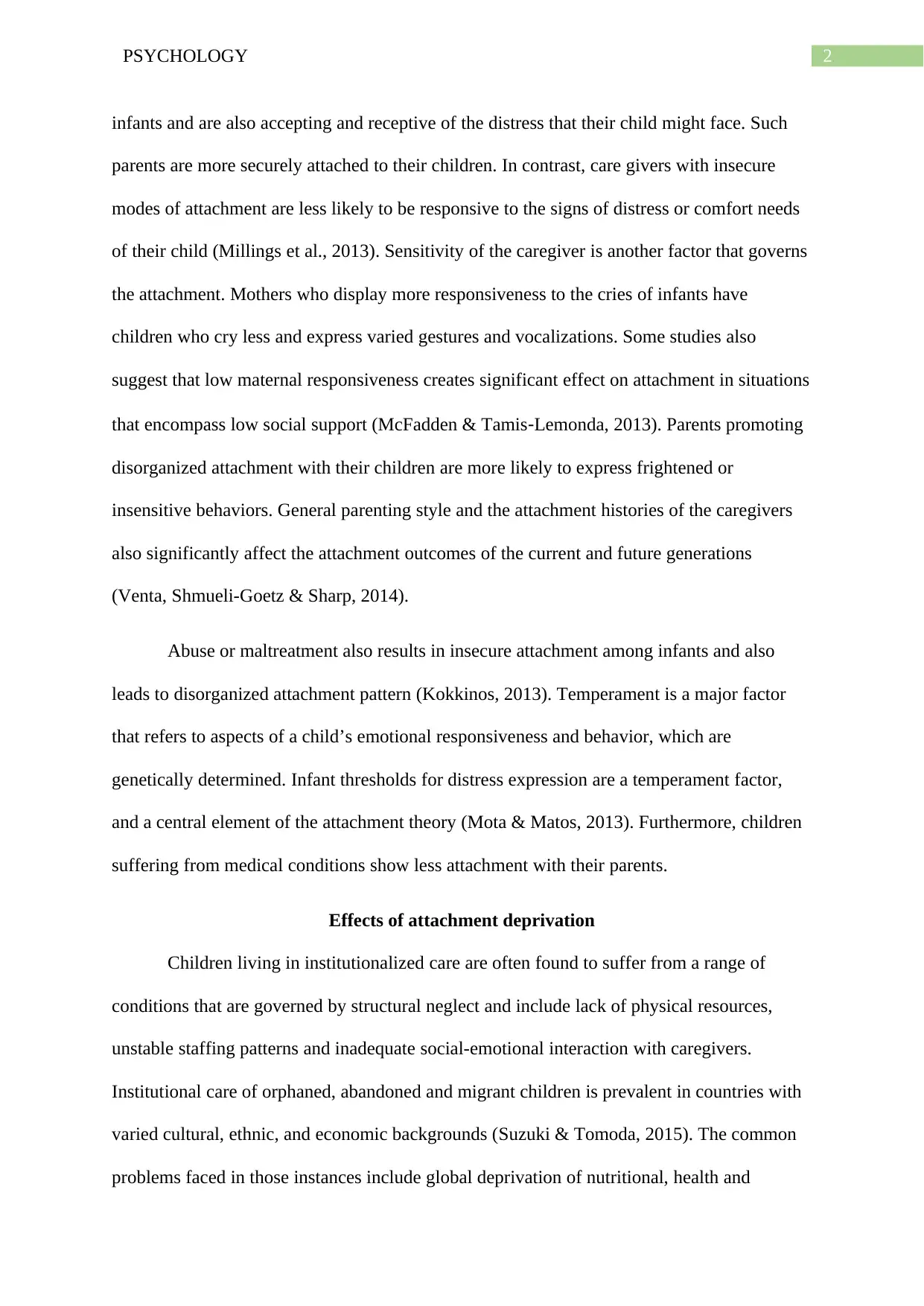
2PSYCHOLOGY
infants and are also accepting and receptive of the distress that their child might face. Such
parents are more securely attached to their children. In contrast, care givers with insecure
modes of attachment are less likely to be responsive to the signs of distress or comfort needs
of their child (Millings et al., 2013). Sensitivity of the caregiver is another factor that governs
the attachment. Mothers who display more responsiveness to the cries of infants have
children who cry less and express varied gestures and vocalizations. Some studies also
suggest that low maternal responsiveness creates significant effect on attachment in situations
that encompass low social support (McFadden & Tamis‐Lemonda, 2013). Parents promoting
disorganized attachment with their children are more likely to express frightened or
insensitive behaviors. General parenting style and the attachment histories of the caregivers
also significantly affect the attachment outcomes of the current and future generations
(Venta, Shmueli-Goetz & Sharp, 2014).
Abuse or maltreatment also results in insecure attachment among infants and also
leads to disorganized attachment pattern (Kokkinos, 2013). Temperament is a major factor
that refers to aspects of a child’s emotional responsiveness and behavior, which are
genetically determined. Infant thresholds for distress expression are a temperament factor,
and a central element of the attachment theory (Mota & Matos, 2013). Furthermore, children
suffering from medical conditions show less attachment with their parents.
Effects of attachment deprivation
Children living in institutionalized care are often found to suffer from a range of
conditions that are governed by structural neglect and include lack of physical resources,
unstable staffing patterns and inadequate social-emotional interaction with caregivers.
Institutional care of orphaned, abandoned and migrant children is prevalent in countries with
varied cultural, ethnic, and economic backgrounds (Suzuki & Tomoda, 2015). The common
problems faced in those instances include global deprivation of nutritional, health and
infants and are also accepting and receptive of the distress that their child might face. Such
parents are more securely attached to their children. In contrast, care givers with insecure
modes of attachment are less likely to be responsive to the signs of distress or comfort needs
of their child (Millings et al., 2013). Sensitivity of the caregiver is another factor that governs
the attachment. Mothers who display more responsiveness to the cries of infants have
children who cry less and express varied gestures and vocalizations. Some studies also
suggest that low maternal responsiveness creates significant effect on attachment in situations
that encompass low social support (McFadden & Tamis‐Lemonda, 2013). Parents promoting
disorganized attachment with their children are more likely to express frightened or
insensitive behaviors. General parenting style and the attachment histories of the caregivers
also significantly affect the attachment outcomes of the current and future generations
(Venta, Shmueli-Goetz & Sharp, 2014).
Abuse or maltreatment also results in insecure attachment among infants and also
leads to disorganized attachment pattern (Kokkinos, 2013). Temperament is a major factor
that refers to aspects of a child’s emotional responsiveness and behavior, which are
genetically determined. Infant thresholds for distress expression are a temperament factor,
and a central element of the attachment theory (Mota & Matos, 2013). Furthermore, children
suffering from medical conditions show less attachment with their parents.
Effects of attachment deprivation
Children living in institutionalized care are often found to suffer from a range of
conditions that are governed by structural neglect and include lack of physical resources,
unstable staffing patterns and inadequate social-emotional interaction with caregivers.
Institutional care of orphaned, abandoned and migrant children is prevalent in countries with
varied cultural, ethnic, and economic backgrounds (Suzuki & Tomoda, 2015). The common
problems faced in those instances include global deprivation of nutritional, health and
⊘ This is a preview!⊘
Do you want full access?
Subscribe today to unlock all pages.

Trusted by 1+ million students worldwide
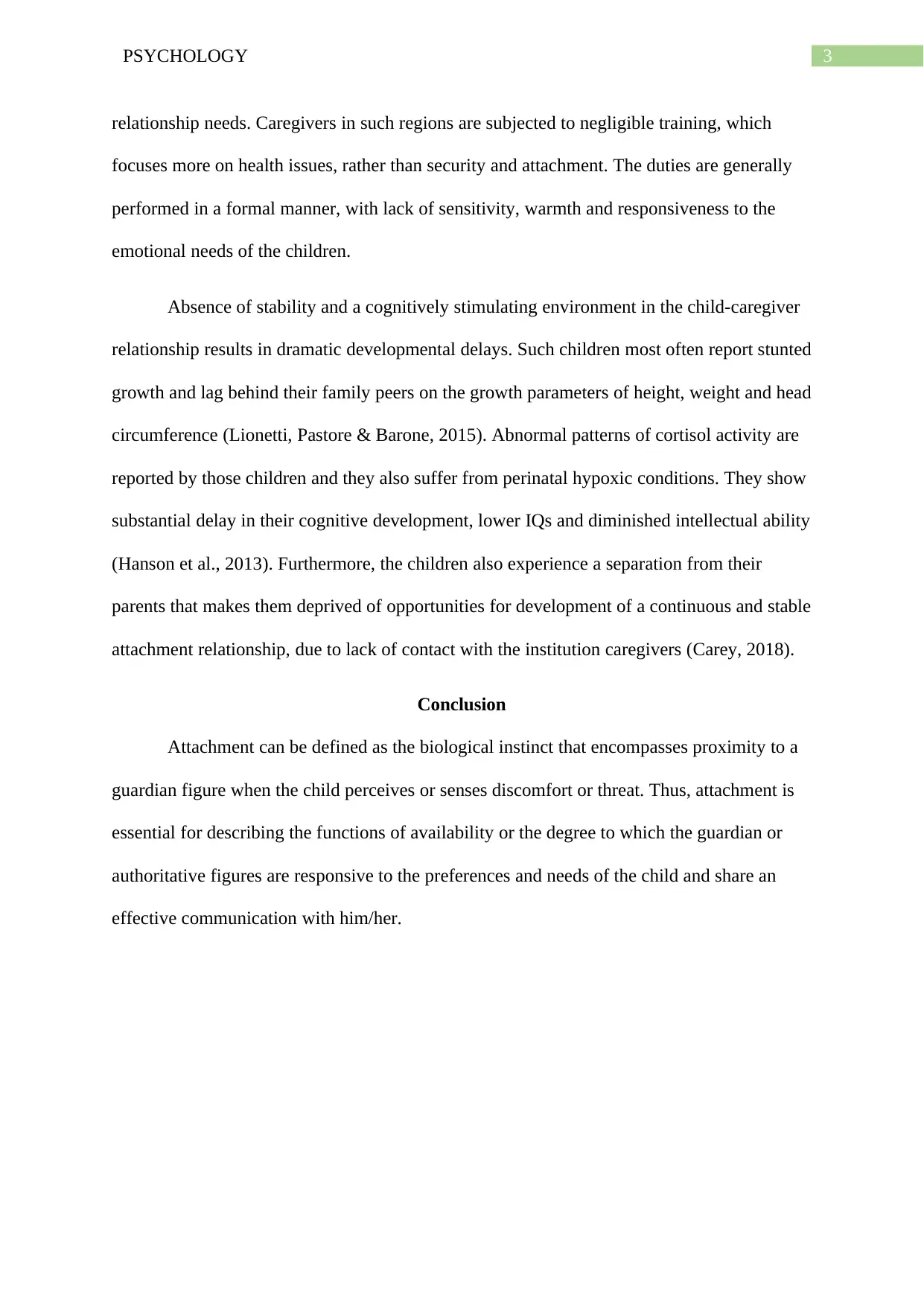
3PSYCHOLOGY
relationship needs. Caregivers in such regions are subjected to negligible training, which
focuses more on health issues, rather than security and attachment. The duties are generally
performed in a formal manner, with lack of sensitivity, warmth and responsiveness to the
emotional needs of the children.
Absence of stability and a cognitively stimulating environment in the child-caregiver
relationship results in dramatic developmental delays. Such children most often report stunted
growth and lag behind their family peers on the growth parameters of height, weight and head
circumference (Lionetti, Pastore & Barone, 2015). Abnormal patterns of cortisol activity are
reported by those children and they also suffer from perinatal hypoxic conditions. They show
substantial delay in their cognitive development, lower IQs and diminished intellectual ability
(Hanson et al., 2013). Furthermore, the children also experience a separation from their
parents that makes them deprived of opportunities for development of a continuous and stable
attachment relationship, due to lack of contact with the institution caregivers (Carey, 2018).
Conclusion
Attachment can be defined as the biological instinct that encompasses proximity to a
guardian figure when the child perceives or senses discomfort or threat. Thus, attachment is
essential for describing the functions of availability or the degree to which the guardian or
authoritative figures are responsive to the preferences and needs of the child and share an
effective communication with him/her.
relationship needs. Caregivers in such regions are subjected to negligible training, which
focuses more on health issues, rather than security and attachment. The duties are generally
performed in a formal manner, with lack of sensitivity, warmth and responsiveness to the
emotional needs of the children.
Absence of stability and a cognitively stimulating environment in the child-caregiver
relationship results in dramatic developmental delays. Such children most often report stunted
growth and lag behind their family peers on the growth parameters of height, weight and head
circumference (Lionetti, Pastore & Barone, 2015). Abnormal patterns of cortisol activity are
reported by those children and they also suffer from perinatal hypoxic conditions. They show
substantial delay in their cognitive development, lower IQs and diminished intellectual ability
(Hanson et al., 2013). Furthermore, the children also experience a separation from their
parents that makes them deprived of opportunities for development of a continuous and stable
attachment relationship, due to lack of contact with the institution caregivers (Carey, 2018).
Conclusion
Attachment can be defined as the biological instinct that encompasses proximity to a
guardian figure when the child perceives or senses discomfort or threat. Thus, attachment is
essential for describing the functions of availability or the degree to which the guardian or
authoritative figures are responsive to the preferences and needs of the child and share an
effective communication with him/her.
Paraphrase This Document
Need a fresh take? Get an instant paraphrase of this document with our AI Paraphraser
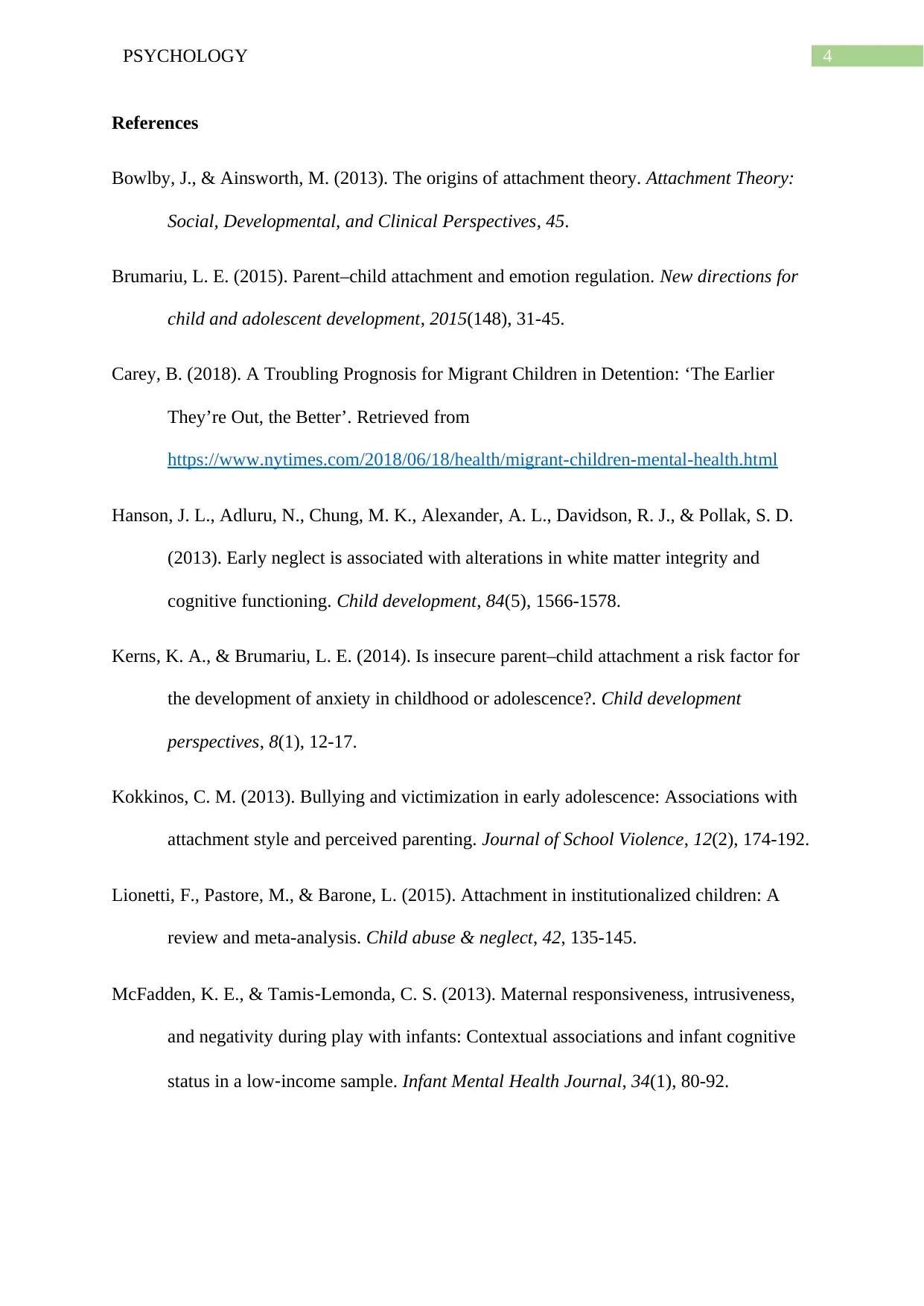
4PSYCHOLOGY
References
Bowlby, J., & Ainsworth, M. (2013). The origins of attachment theory. Attachment Theory:
Social, Developmental, and Clinical Perspectives, 45.
Brumariu, L. E. (2015). Parent–child attachment and emotion regulation. New directions for
child and adolescent development, 2015(148), 31-45.
Carey, B. (2018). A Troubling Prognosis for Migrant Children in Detention: ‘The Earlier
They’re Out, the Better’. Retrieved from
https://www.nytimes.com/2018/06/18/health/migrant-children-mental-health.html
Hanson, J. L., Adluru, N., Chung, M. K., Alexander, A. L., Davidson, R. J., & Pollak, S. D.
(2013). Early neglect is associated with alterations in white matter integrity and
cognitive functioning. Child development, 84(5), 1566-1578.
Kerns, K. A., & Brumariu, L. E. (2014). Is insecure parent–child attachment a risk factor for
the development of anxiety in childhood or adolescence?. Child development
perspectives, 8(1), 12-17.
Kokkinos, C. M. (2013). Bullying and victimization in early adolescence: Associations with
attachment style and perceived parenting. Journal of School Violence, 12(2), 174-192.
Lionetti, F., Pastore, M., & Barone, L. (2015). Attachment in institutionalized children: A
review and meta-analysis. Child abuse & neglect, 42, 135-145.
McFadden, K. E., & Tamis‐Lemonda, C. S. (2013). Maternal responsiveness, intrusiveness,
and negativity during play with infants: Contextual associations and infant cognitive
status in a low‐income sample. Infant Mental Health Journal, 34(1), 80-92.
References
Bowlby, J., & Ainsworth, M. (2013). The origins of attachment theory. Attachment Theory:
Social, Developmental, and Clinical Perspectives, 45.
Brumariu, L. E. (2015). Parent–child attachment and emotion regulation. New directions for
child and adolescent development, 2015(148), 31-45.
Carey, B. (2018). A Troubling Prognosis for Migrant Children in Detention: ‘The Earlier
They’re Out, the Better’. Retrieved from
https://www.nytimes.com/2018/06/18/health/migrant-children-mental-health.html
Hanson, J. L., Adluru, N., Chung, M. K., Alexander, A. L., Davidson, R. J., & Pollak, S. D.
(2013). Early neglect is associated with alterations in white matter integrity and
cognitive functioning. Child development, 84(5), 1566-1578.
Kerns, K. A., & Brumariu, L. E. (2014). Is insecure parent–child attachment a risk factor for
the development of anxiety in childhood or adolescence?. Child development
perspectives, 8(1), 12-17.
Kokkinos, C. M. (2013). Bullying and victimization in early adolescence: Associations with
attachment style and perceived parenting. Journal of School Violence, 12(2), 174-192.
Lionetti, F., Pastore, M., & Barone, L. (2015). Attachment in institutionalized children: A
review and meta-analysis. Child abuse & neglect, 42, 135-145.
McFadden, K. E., & Tamis‐Lemonda, C. S. (2013). Maternal responsiveness, intrusiveness,
and negativity during play with infants: Contextual associations and infant cognitive
status in a low‐income sample. Infant Mental Health Journal, 34(1), 80-92.

5PSYCHOLOGY
Millings, A., Walsh, J., Hepper, E., & O’Brien, M. (2013). Good partner, good parent:
Responsiveness mediates the link between romantic attachment and parenting
style. Personality and Social Psychology Bulletin, 39(2), 170-180.
Mota, C. P., & Matos, P. M. (2013). Peer attachment, coping, and self-esteem in
institutionalized adolescents: The mediating role of social skills. European journal of
psychology of education, 28(1), 87-100.
Pallini, S., Baiocco, R., Schneider, B. H., Madigan, S., & Atkinson, L. (2014). Early child–
parent attachment and peer relations: A meta-analysis of recent research. Journal of
Family Psychology, 28(1), 118.
Pietromonaco, P. R., Uchino, B., & Dunkel Schetter, C. (2013). Close relationship processes
and health: implications of attachment theory for health and disease. Health
Psychology, 32(5), 499.
Suzuki, H., & Tomoda, A. (2015). Roles of attachment and self-esteem: impact of early life
stress on depressive symptoms among Japanese institutionalized children. BMC
psychiatry, 15(1), 8.
Venta, A., Shmueli-Goetz, Y., & Sharp, C. (2014). Assessing attachment in adolescence: A
psychometric study of the Child Attachment Interview. Psychological
Assessment, 26(1), 238.
Millings, A., Walsh, J., Hepper, E., & O’Brien, M. (2013). Good partner, good parent:
Responsiveness mediates the link between romantic attachment and parenting
style. Personality and Social Psychology Bulletin, 39(2), 170-180.
Mota, C. P., & Matos, P. M. (2013). Peer attachment, coping, and self-esteem in
institutionalized adolescents: The mediating role of social skills. European journal of
psychology of education, 28(1), 87-100.
Pallini, S., Baiocco, R., Schneider, B. H., Madigan, S., & Atkinson, L. (2014). Early child–
parent attachment and peer relations: A meta-analysis of recent research. Journal of
Family Psychology, 28(1), 118.
Pietromonaco, P. R., Uchino, B., & Dunkel Schetter, C. (2013). Close relationship processes
and health: implications of attachment theory for health and disease. Health
Psychology, 32(5), 499.
Suzuki, H., & Tomoda, A. (2015). Roles of attachment and self-esteem: impact of early life
stress on depressive symptoms among Japanese institutionalized children. BMC
psychiatry, 15(1), 8.
Venta, A., Shmueli-Goetz, Y., & Sharp, C. (2014). Assessing attachment in adolescence: A
psychometric study of the Child Attachment Interview. Psychological
Assessment, 26(1), 238.
⊘ This is a preview!⊘
Do you want full access?
Subscribe today to unlock all pages.

Trusted by 1+ million students worldwide
1 out of 6
Related Documents
Your All-in-One AI-Powered Toolkit for Academic Success.
+13062052269
info@desklib.com
Available 24*7 on WhatsApp / Email
![[object Object]](/_next/static/media/star-bottom.7253800d.svg)
Unlock your academic potential
Copyright © 2020–2025 A2Z Services. All Rights Reserved. Developed and managed by ZUCOL.





